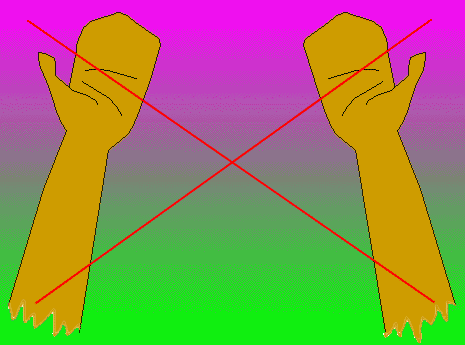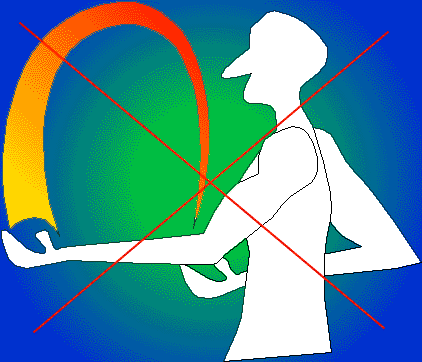

Begin by standing straight, with the weight distributed equally over both legs (if you stand shifted to one side, the hands will not be doing precisely the same thing, and the whole juggling patter will be asymmetric). Let the arms hand straight down from the shoulders at the side of the trunk. Bend the elbows to 90° and supinnate the forearms (so that the palms are face up). This is home position.





The ball: it is better to use a ball with some weight rather than something very light. Avoid balls that have a lot of bounce (they tend to bounce out of the catching hand). The ideal ball is something sort of squishy like a bean bag which will make the catches very easy and also don’t tend to roll under the couch every time you drop one.
By the way, it is absolutely necessary to drop very often in order to learn to juggle (or to learn new tricks). It’s a good idea to practice in front of a couch or bed so you don’t have as far to bend over to pick up dropped balls. Also standing in front of a flat wall helps maintain the plane of juggling (see below).
The most important thing to remember as you begin tossing and catching the ball is that juggling is not about making difficult catches. The emphasis should be on making perfect throws that land exactly in the palm of the “cathing” hand with no effort. If at any point you find yourself chasing bad throws, concentrate on improving the throws and don’t worry about trying to catch bad ones.
The toss is unlike throws for most sports: you throw with the palm of the hand rather than using the fingers and try not to impart any spin. Trying throwing one ball about the height of the eyes from one hand to the other. The force should come from the palm of the hand directed to the bottom of the ball. Avoid any exagerated “wind up” motions. If the ball falls exactly into the other hand (which should not happend the first time), you have thrown it perfectly. If it does not, simply observe where it goes. Is it too far away from the body? Is it too close to the body? Is it too wide? Etc.
Practice throwing from one hand to the other, then stop and readjust to home position, then throw from that hand back to the first. Try to throw moving just the forearms (i.e. the elbows remain more or less stationary hanging from the shoulders at the sides of the trunk). Throw in a flat plane paralell to the plane of the body as shown:


Start in home position with one ball in the palm of each hand. First, throw the ball from your non-dominant hand (the left hand for right-handed people). As that ball is on its way down, throw the ball in the other hand underneath and inside of the descending ball just before catching the first ball. Then catch the second ball in the first hand. This is the exchange. What you are doing is trading the ball in your hand for the ball in the air. This is at least 80% of juggling. The hand that does the exchange will make a small clockwise circle (from the juggler’s point of view). Throw at 9 o’clock and catch at 3 o’clock. Again, the move itself is pretty simple, so we’ll spend more time on what not to do:

After you feel comfortable with the exchange on one side, try the other. That is, start by throwing from your dominant hand (which means your non-dominant hand is doing the more difficult part, the throw/catch exchange). When that is comfortable (still not rushing it at all—go slow), try alternating beginning with one hand first, then the other. A nice way to practice this is to identify the starter ball (maybe it’s a different color or something). Whichever hand has the starter ball should throw first.
The 2 ball exchange is really all that juggling is (over and over again). Since it is so integral, make sure you really have this stage perfected before you play around with 3 balls. If you rush through it, you may find yourself with some bad habits which are very difficult to un-learn.
Before we try continuous 3 ball juggling, we’ll do the same exchange we’ve been doing, while holding the third ball as a “rider.” If you hold the rider using the pinky and ring fingers to sandwich the ball against the heel of your hand, you will have three digits free to hold the starter ball: the thumb, index and middle fingers as shown below:

Now do the same throw - exchange - catch move you did for 2 ball practice. For now, just keep the rider in its place wedged against the heel of the hand. What you are actually practicing is the initial throw and the final catch of continuous three ball juggling (these are the only instances when there are 2 balls in one hand at the same time). Most people learn this with just their dominant hand. It’s not a bad idea to practice it with both, but not terribly essential. (By the way, there is quite a bit of transferred learning that goes on. What you learn painstakingly on one side can sometimes transfer to the other cerebral hemisphere with little or no practice.)
Now try two exchanges consecutively. Throw the starter ball (always start with the hand holding two balls), exchange on the other side, then let the rider move from its position to the center of the ball (you actually do this immediately after throwing the starter ball) so it may be exchanged with the ball coming from the first exchange. Then make the final catch (two ball in one hand) in the non-dominant hand. The rhythm is throw - exchange - exchange - catch.
When you can do this, you are ready to juggle 3 balls continuously. Simply continue making exchanges. At any given instant (after the start) you will have one ball in each hand and one ball in the air. 3 ball cascade juggling is a matter of swapping the ball in the air for one of the balls in your hands over and over again.